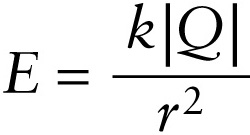Magnitude of the electric field due to a point charge (16-4)
Question 1 of 4
Question
Distance between point charge \(Q\) and the location where the field is measured
{"title":"Magnitude of the electric field due to a point charge Q","description":"Incorrect","type":"incorrect","color":"#99CCFF","code":"[{\"shape\":\"poly\",\"coords\":\"82,133\"},{\"shape\":\"rect\",\"coords\":\"10,16,12,16\"},{\"shape\":\"poly\",\"coords\":\"144,22\"},{\"shape\":\"rect\",\"coords\":\"5,50,40,94\"}]"} {"title":"Coulomb constant","description":"Wrong","type":"incorrect","color":"#ffcc00","code":"[{\"shape\":\"rect\",\"coords\":\"125,2,160,49\"}]"} {"title":"Absolute value of charge Q","description":"Wrong","type":"incorrect","color":"#333300","code":"[{\"shape\":\"rect\",\"coords\":\"175,3,225,64\"}]"} {"title":"Distance between point charge Q and the location where the field is measured","description":"Correct!","type":"correct","color":"#000080","code":"[{\"shape\":\"rect\",\"coords\":\"153,98,183,135\"}]"}Review
We can use Coulomb’s law, Equation 16-1, to write an expression for the magnitude of the electric field due to a point charge \(Q\). If we place a test charge \(q\) a distance \(r\) from charge \(Q\), Equation 16-1 tells us that the magnitude of the Coulomb force on \(q\) is \(F = k\left|q\right|\left|Q\right|r^2\). From Equation 16-2, we can also write this force magnitude as \(F = \left|q\right|E\), where \(E\) is the magnitude of the electric field due to charge \(Q\) at the position of test charge \(q\). Setting these two expressions for \(F\) equal to each other, we get
\(\left|q\right|E = \frac{k\left|q\right|\left|Q\right|}{r^2}\)
or

